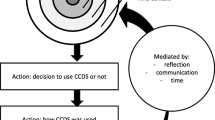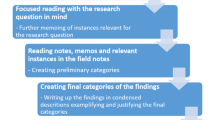Abstract
Information and communication technologies are an important driver for network-based forms of governance. These technologies include computer decision support systems (CDSS) and software algorithms deployed to improve, optimise and manage health service delivery as in the case presented here, the NHS Pathways CDSS. This CDSS operates an algorithm, drawing on an extensive repository of clinical information to support NHS urgent and emergency care telephone triage services. Call handlers using the CDSS make decisions about whether the caller needs an immediate ambulance or can wait to see a general practitioner, and they can also provide advice about self-care. This chapter presents data from two large, comparative ethnographic studies of this CDSS which provide data from over 850 hours of observation, surveys of 700 staff, and interviews and focus group data from over 100 staff. Here I explore the interpretive gap between the promise of digital governance and the attempt to bring this computer technology into use as a way of managing demand for care. The chapter argues that, at its heart the CDSS maintains a model of ‘perfect governance’, premised upon the idea that triage is a rational, rule-governed, standardisable process. The reality, as we will see, is that this vision is thwarted, adapted, and resisted in the everyday situated practices and networks of care that involve human and non-human actors. The chapter presents a thematic analysis of a series of assumptive rules about disease presentation and decision-making to demonstrate how digital governance is resisted.
Access this chapter
Tax calculation will be finalised at checkout
Purchases are for personal use only
Similar content being viewed by others
References
Beer, D. (2017). The social power of algorithms. Information, Communication & Society, 20(1), 1–13.
Berg, M. (1997). Problems and promises of the protocol. Social Science and Medicine, 44(8), 1081–1088.
Bevir, M. (2011a). A decentred theory of governance. In H. Bang (Ed.), Governance as social and political communication. Manchester: Manchester University Press.
Bevir, M. (Ed.). (2011b). The SAGE handbook of governance. London: Sage.
Bevir, M., & Rhodes, R. A. W. (2007). Decentred theory, change and network governance. In E. Sorensen & J. Torfing (Eds.), Theories of democratic network governance (pp. 77–91). New York, NY: Palgrave Macmillan.
Bevir, M., & Richards, D. (2009). Decentring policy networks: A theoretical agenda. Public Administration, 87(1), 3–14.
Castells, M. (1996). The network society. Oxford: Basil Blackwell.
Castells, M. (2000). Materials for an exploratory theory of the network society. British Journal of Sociology, 51(1), 5–24.
Dowding, D., Mitchell, N., Randell, R., Foster, R., Lattimer, V., & Thompson, C. (2009). Nurses’ use of computerised clinical decision support systems: A case site analysis. Journal of Clinical Nursing, 18, 1159–1167.
Ferlie, E., et al. (2010). Networks in health care: A comparative study of their management, impact and performance. Report for the National Institute for Health Research Service Delivery and Organisation Programme SDO Project (08/1518/102). http://www.netscc.ac.uk/hsdr/files/project/SDO_FR_08-1518-102_V01.pdf. Accessed 29 April 2019.
Ferlie, E., Fitzgerald, L., McGivern, G., Dopson, S., & Bennett, C. P. (2011). Public policy networks and ‘wicked problems’: A nascent solution? Public Administration, 89(2), 307–324.
Ferlie, E., Fitzgerald, L., McGivern, G., Dopson, S., & Bennett, C. P. (2013). Making wicked problems governable. Oxford: Oxford University Press.
Ferlie, E., & Pettigrew, A. (1996). Managing through networks: Some issues and implications for the NHS. British Journal of Management, 7(s1): S81–S99.
Greatbatch, D., Hanlon, G., Goode, J., O’Cathain, A., Strangleman, T., & Luff, D. (2005). Telephone triage, expert systems and clinical expertise. Sociology of Health & Illness, 27, 802–830.
Hanlon, G., Strangleman, T., Goode, J., Luff, D., O’Cathain, A., & Greatbatch, D. (2005). Knowledge, technology and nursing: The case of NHS Direct. Human Relations, 58(2), 147–171.
Hughes, D. (1989). Paper and people: The work of the casualty reception clerk. Sociology of Health & Illness, 11(4), 382–408.
Latour, B. (1987). Science in action: How to follow scientists and engineers through society. Milton Keynes: Open University Press.
Latour, B. (2005). Reassembling the social: An introduction to actor-network-theory. Oxford: Oxford University Press.
Law, J. (Ed.). (1986). Power, action and belief: A new sociology of knowledge. London: Routledge & Kegan Paul.
NHS England. (2016). NHS 111 Minimum data set 2015–16. https://www.england.nhs.uk/statistics/statistical-work-areas/nhs-111-minimum-data-set/nhs-111-minimum-data-set-2015-16/. Accessed 29 April 2019.
Nicolini, D., Waring, J., & Mengis, J. (2011). Policy and practice in the use of root cause analysis to investigate clinical adverse events: Mind the gap. Social Science and Medicine, 73, 217–225.
Pearson, S. A., Moxey, A., Robertson, J., Hains, I., Williamson, M., Reeve, J., et al. (2009). Do computerised clinical decision support systems for prescribing change practice? A systematic review of the literature (1990–2007). BMC Health Services Research, 9, 154. PMID: 19715591.
Petrakaki, D., Hilburg, E., & Waring, J. (2018). Between empowerment and self-discipline: Governing patients’ conduct through technological self-care. Social Science and Medicine, 213, 146–153.
Pope, C., Halford, S., Turnbull, J., Prichard, J., Calestani, M., & May, C. (2013). Using computer decision support systems in NHS emergency and urgent care: Ethnographic study using Normalisation Process Theory. BMC Health Services Research, 13, 111.
Robertson-Steel, I. (2006). Evolution of triage systems. Emergency Medicine Journal, 23(2), 154–155.
Ruston, A. (2006). Interpreting and managing risk in a machine bureaucracy: Professional decision-making in NHS Direct. Health, Risk & Society, 8, 257–271.
Turner, J., Lattimer, V., & Snooks, H. (2008). An evaluation of the accuracy and safety of NHS Pathways. Sheffield: Medical Care Research Unit, University of Sheffield.
Acknowledgements
Thanks are due to the research teams on the series of projects that provided the data used in this chapter. They include Joanne Turnbull, Jane Prichard, Susan Halford, Gemma McKenna, Alison Rowsell, Melania Calestani, Val Latimer, Carl May, Simon Brook, Jeremy Jones, Christine Barrett, Andrew Lennon, and Rob Crouch. The empirical work could not have been completed without them, or the willing participation of the many people involved in the case studies. The good parts of the thinking presented here are due to their input and that of the team involved with this book. Any errors or failings that remain, are mine to own.
The research reported here was funded by the National Institute for Health Research (NIHR) [Research grants SDO 08/1819/217; SDO 10/1008/10; HS&DR 14/19/16]. The views expressed are those of the author and not necessarily those of the NIHR or the Department of Health and Social Care.
Author information
Authors and Affiliations
Corresponding author
Editor information
Editors and Affiliations
Rights and permissions
Copyright information
© 2020 The Author(s)
About this chapter
Cite this chapter
Pope, C. (2020). Situating Practices of Human and Non-human Networks in the Delivery of Emergency and Urgent Care Services. In: Bevir, M., Waring, J. (eds) Decentring Health and Care Networks. Organizational Behaviour in Healthcare. Palgrave Macmillan, Cham. https://doi.org/10.1007/978-3-030-40889-3_6
Download citation
DOI: https://doi.org/10.1007/978-3-030-40889-3_6
Published:
Publisher Name: Palgrave Macmillan, Cham
Print ISBN: 978-3-030-40888-6
Online ISBN: 978-3-030-40889-3
eBook Packages: Business and ManagementBusiness and Management (R0)




